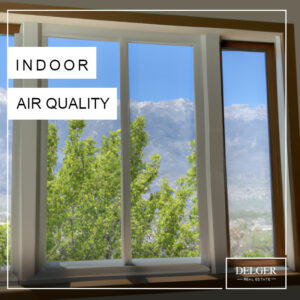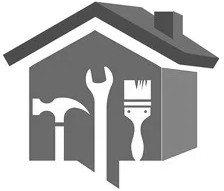Indoor Air Quality
 Indoor air quality (IAQ) in homes is a growing concern as people spend more time indoors due to work, school and leisure activities. The average person spends about 90% of their time indoors. The air inside a home can be up to five times more polluted than the air outside, and this can have a significant impact on the health and well-being of residents. Poor IAQ can cause a wide range of health problems, including allergies, asthma, and respiratory infections. It can also lead to headaches, fatigue, and poor concentration.
Indoor air quality (IAQ) in homes is a growing concern as people spend more time indoors due to work, school and leisure activities. The average person spends about 90% of their time indoors. The air inside a home can be up to five times more polluted than the air outside, and this can have a significant impact on the health and well-being of residents. Poor IAQ can cause a wide range of health problems, including allergies, asthma, and respiratory infections. It can also lead to headaches, fatigue, and poor concentration.
One of the most common sources of poor IAQ in homes is poor ventilation. When homes are sealed to conserve energy, pollutants such as carbon monoxide, radon, and volatile organic compounds (VOCs) can build up inside. Another source of indoor air pollution is the use of chemicals and cleaning products. Many of these products emit VOCs, which can cause eye, nose, and throat irritation, headaches, and dizziness.
To improve IAQ in homes, it’s important to ensure that the home has proper ventilation. This can be achieved by installing mechanical ventilation systems or by opening windows and doors to allow fresh air to circulate. It’s also important to avoid the use of toxic cleaning products and chemicals, and to use natural alternatives when possible.
How frequently air is “exchanged” indoors is important. The standard is typically measured in Air Changes per Hour (ACH). The recommended ACH rate for a surgery room is typically between 15 and 20 air changes per hour. This means that the entire volume of air in the room is replaced with fresh air from outside the building or from a dedicated air handling unit, 15 to 20 times per hour. Additionally, the air in operating rooms is typically passed through HEPA filters to remove particles and microorganisms, this helps to maintain the sterile environment.
Obviously residential homes do not need air exchange rates that high. The recommended air exchange rate for a residential home is generally much lower than that for a hospital operating room. The American Society of Heating, Refrigerating, and Air-Conditioning Engineers (ASHRAE) recommends a minimum of 0.35 air changes per hour (ACH) for homes. However, this can vary depending on factors such as the size of the home, the number of occupants, and the level of pollution in the area.
In general, a higher ACH rate is recommended for homes in areas with high levels of pollution or homes with residents who have respiratory issues. It is also recommended that homes have proper ventilation systems such as exhaust fans in the kitchen and bathrooms, and mechanical ventilation systems such as heat recovery ventilators or energy recovery ventilators to bring in fresh air and remove stale air.
Another important step in improving IAQ is to address any moisture problems in the home, such as leaks or high humidity levels. Moisture can lead to the growth of mold, which can release allergens and irritants into the air. Homeowners should be aware of the signs of mold, such as musty odors, discoloration on walls, and visible mold growth, and take steps to address any mold issues as soon as they are detected.
Furnace Filters
Regularly changing furnace filters, vacuuming, and dusting are also important for improving IAQ. In addition, using air purifiers, plants, and humidifiers can also help to remove pollutants and allergens from the air.
There are several rating systems for home furnace filters, but three of the most common are MERV (Minimum Efficiency Reporting Value), MPR (Micro-Particle Performance Rating), and FPR (Filter Performance Rating).
MERV (Minimum Efficiency Reporting Value) is a measure of a filter’s ability to remove particles from the air. The higher the MERV rating, the more efficient the filter. MERV ratings range from 1 to 20, with 20 being the most efficient.
MPR (Micro-Particle Performance Rating) is a rating system developed by 3M for rating the performance of furnace filters. The higher the MPR number, the more efficient the filter is. MPR ranges from 100 to 3000.
FPR (Filter Performance Rating) is a rating system developed by The Home Depot for rating the performance of furnace filters. The higher the FPR number, the more efficient the filter is. FPR ranges from 1 to 10, with 10 being the most efficient.
Please note that MERV, MPR, and FPR are not interchangeable and different manufacturers may use different standards. MERV is considered the industry standard when it comes to air filter ratings and is generally the most used system. The MPR rating is the most granular of the ratings. The following table details each filter rating, along with what level of particles they can effectively filter.
| MERV | MERV 8 |
MERV 8 |
MERV 11 |
MERV 11 |
MERV 11 |
MERV 13 |
MERV 13 |
MERV 13 |
|---|---|---|---|---|---|---|---|---|
| FPR | FPR 4-5 |
FPR 6-7 |
FPR 6-7 |
FPR 8-9 |
FPR 8-9 |
FPR 10 |
FPR 10 |
FPR 10 |
| MPR | MPR 600 |
MPR 1000 |
MPR 1200+ |
MPR 1500 |
MPR 1550 |
MPR 1900 |
MPR 2200 |
MPR 2800 |
| Lint | Y | Y | Y | Y | Y | Y | Y | Y |
| Household Dust | Y | Y | Y | Y | Y | Y | Y | Y |
| Dust Mite Debris | Y | Y | Y | Y | Y | Y | Y | Y |
| Mold Spores | Y | Y | Y | Y | Y | Y | Y | Y |
| Pollen | Y | Y | Y | Y | Y | Y | Y | Y |
| Pet Dander | Y | Y | Y | Y | Y | Y | Y | |
| Smoke/Smog | Y | Y | Y | Y | Y | Y | Y | |
| Cough/Sneeze Particles | Y | Y | Y | Y | Y | Y | ||
| Bacteria | Y | Y | Y | Y | Y | |||
| Virus | Y | Y | Y | Y | Y | |||
| Candle Soot | Y | Y | Y | |||||
| PM 2.5 Particles | Y | Y | Y | |||||
| Exhaust Particles | Y | Y | ||||||
| Ultrafine Particles | Y |
We recommend homeowners to have regular Indoor Air Quality measurements performed to ensure that the air inside your home is safe and healthy to breath.
Real Estate Maintenance
 Are you in need of a reliable property maintenance company in Bozeman? Look no further!
Are you in need of a reliable property maintenance company in Bozeman? Look no further!
Find out more about Bozeman Property Maintenance from Delger Real Estate. We offer maintenance services for both commercial & residential properties. No job is too small!
Call us at 406-581-7504 for more information about our Property Maintenance Services and to schedule an appointment.
Category : Healthy Home , Home Maintenance , Lifestyle

